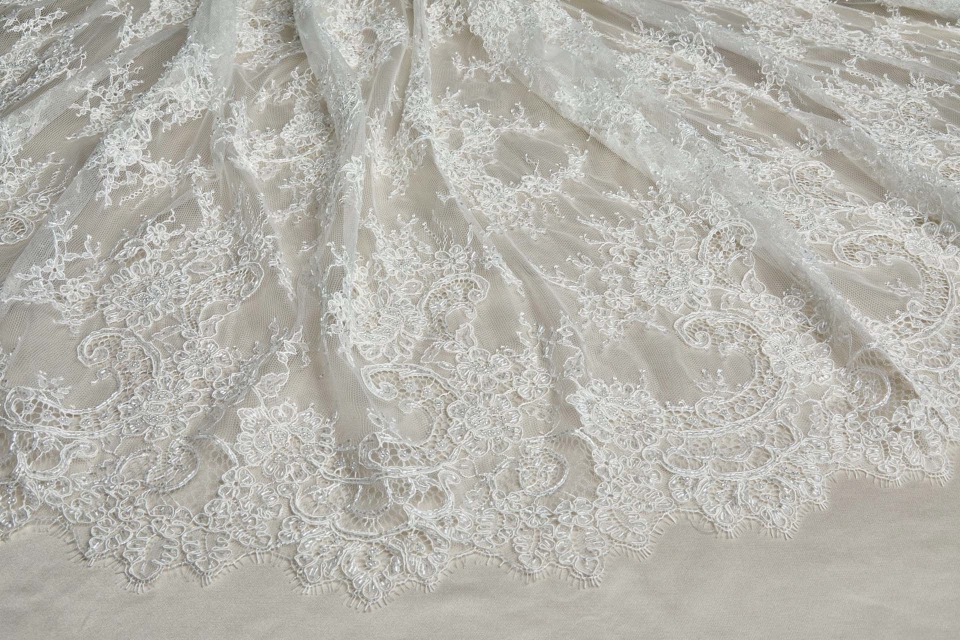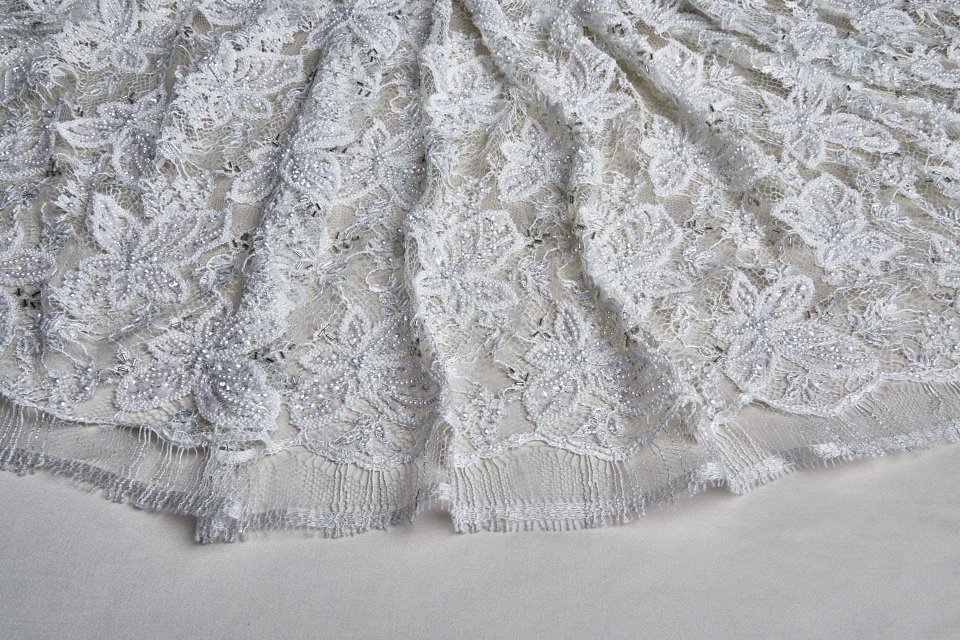We use cookies to make your experience better. To comply with the new e-Privacy directive, we need to ask for your consent to set the cookies. Learn more.
Lace Fabric
Laces available to buy online include: Beaded Lace, Leavers Lace, French Lace, Coloured Lace, Chantilly Lace, Corded Lace & Guipure Lace. Please use the filters on the left ("shop by" button on small screens) to narrow down the list. If you can't find the perfect lace for your project, please get in touch. We have many more laces available.
-
 Corded Leavers Lace Rose Bunches - VanillaSpecial Price £195.00 Regular Price £260.00
Corded Leavers Lace Rose Bunches - VanillaSpecial Price £195.00 Regular Price £260.00
Lace - Everything you need to know
Lace is a delicate, sensual fabric associated with love and femininity. Perhaps unsuprisingly, laces are used to provide exquisite finishing touches to beautiful bridal wear, delicate lingerie and stunning evening gowns. Lace is also used to make home decor items such as tablecloths and doillies.
Lace is made of yarn or thread in an open weblike pattern, created by various techniques. Each type of lace has its own unique characteristics, methods of production, and applications in fashion and decor. Here is an overview of the main types of lace, their uses, how they are made, and how to care for them:
Types of Lace
-
- Characteristics: Embellished with beads, sequins, or crystals, adding texture and sparkle.
- Uses: Popular for bridal gowns, evening dresses, and accessories like veils and handbags.
- Care: Requires gentle handling. Dry cleaning is recommended to avoid damaging the beads.
-
- Characteristics: Made using the Leavers machine, it is fine and delicate with intricate patterns.
- Uses: Often used in haute couture, lingerie, and bridal wear.
- Care: Should be hand washed or dry cleaned. Avoid wringing or twisting.
-
- Characteristics: Also known as Venetian lace, it has a raised design and no net background, with motifs connected by bars or plaits.
- Uses: Ideal for wedding dresses, evening gowns, and home décor items like tablecloths.
- Care: Hand wash or dry clean. Lay flat to dry to maintain shape.
-
- Characteristics: Lace dyed in various colors, offering a wide range of hues beyond traditional white and ivory.
- Uses: Used in fashion for dresses, tops, and accessories, adding vibrant accents to garments.
- Care: Colorfastness varies, so follow care instructions carefully. Typically hand wash in cold water.
-
- Characteristics: Known for its quality and fine craftsmanship, often made in regions like Calais and Caudry.
- Uses: Widely used in bridal and haute couture gowns.
- Care: Hand wash or dry clean. Store carefully to avoid snags.
-
- Characteristics: Features fine, detailed patterns and a delicate design, often with floral motifs and a scalloped edge.
- Uses: Common in bridal veils, lingerie, and evening wear.
- Care: Extremely delicate, requiring hand washing or professional cleaning.
-
- Characteristics: Features raised patterns outlined with heavier thread or cord, creating a three-dimensional effect.
- Uses: Popular in wedding gowns, evening dresses, and accessories.
- Care: Hand wash or dry clean. Be cautious with the raised cords to avoid fraying.
How Lace is made
-
Handmade Lace:
- Techniques: Includes needle lace (using a needle and thread) and bobbin lace (using bobbins to braid and twist threads).
- Production: Time-consuming and labor-intensive, resulting in intricate and unique patterns.
-
Machine-made Lace:
- Techniques: Uses machines like the Leavers machine, Raschel machine, or Schiffli machine to produce lace more quickly and in larger quantities.
- Production: Allows for consistent quality and complex designs, making lace more accessible.
Uses of Lace in Garments
- Bridal Wear: Lace is a staple in wedding dresses, veils, and accessories, adding elegance and romanticism.
- Evening Wear: Lace is often used in evening gowns and cocktail dresses for its luxurious appearance.
- Lingerie: Lace adds femininity and delicacy to lingerie, providing both beauty and sensuality.
- Casual Wear: Lace details can be found in tops, skirts, and dresses, offering a touch of sophistication.
- Accessories: Lace is used in items like gloves, scarves, and handbags, providing intricate detailing.
Caring for Lace
-
Washing:
- Hand Washing: The safest method for most lace. Use mild detergent and cool water. Gently agitate and rinse thoroughly.
- Machine Washing: If necessary, use a delicate cycle with a mesh laundry bag. Avoid heavy items in the same load.
-
Drying:
- Air Dry: Lay flat on a clean, dry towel. Avoid direct sunlight which can cause fading.
- Avoid Heat: Do not use a tumble dryer as the heat can damage the delicate fibers.
-
Storing:
- Flat Storage: Store flat to prevent stretching and distortion. Use acid-free tissue paper to prevent yellowing.
- Hanging: For garments, use padded hangers to maintain shape. Cover with a breathable garment bag.
-
Ironing:
- Low Heat: If ironing is necessary, use the lowest heat setting and place a cloth between the iron and the lace to prevent direct contact.
-
Maintenance:
- Regular Checks: Inspect lace items regularly for signs of wear or damage. Repair small tears promptly to prevent further damage.
By understanding the different types of lace, their specific uses, and how to care for them, you can appreciate the delicate beauty and versatility of this timeless fabric.























